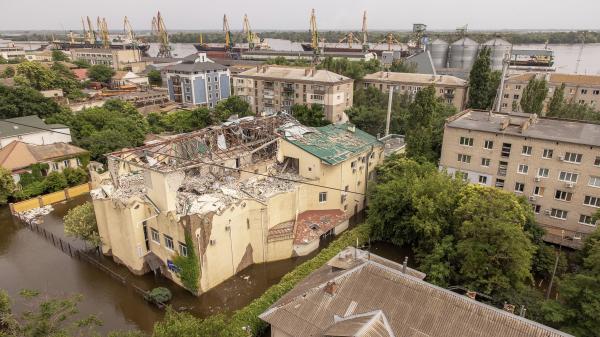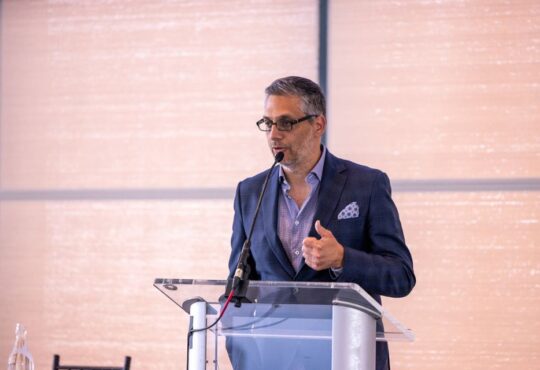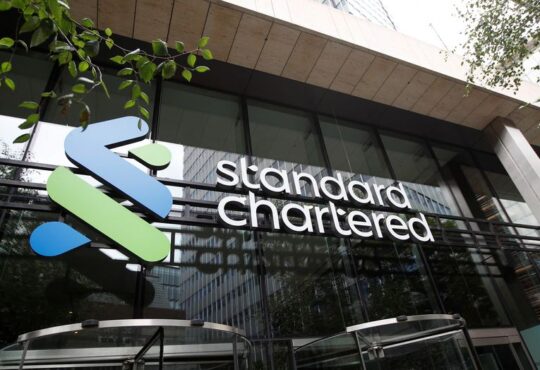
Pretty much every day for the past 17 months, newspapers and TV screens have been filled with images of the destruction wrought in cities across Ukraine.
No one really knows when the war will end, but that has not stopped governments, development banks, and the great and good in general from funnelling funds to aid in the country’s reconstruction.
But how do you rebuild a country in the midst of a war when, every day, vital government and public infrastructure is being destroyed by Russian drones and missiles?
The most recent international needs assessment, based on wartime damage in 2022, suggests the cost of reconstruction in Ukraine could reach as high as $411bn. But with costs mounting by the day, other estimates put the price tag much higher.
At the Ukraine Recovery Conference in Lugano, Switzerland, in July 2022, Ukraine’s prime minister Denys Shmyhal estimated that a 10-year reconstruction effort would cost approximately $750bn. However, the European Investment Bank’s (EIB) president Werner Hoyer says the costs could exceed €1tn.
Rebuilding western Europe after the second world war cost more than $12bn. But where will that $1tn, or whatever the final figure turns out to be, come from?
Donor fatigue
Steve Lewarne, a former principal, now retired, at Deloitte Consulting, says there is no way existing donors and development banks can provide the $1tn or more needed to finance Ukraine’s reconstruction. “It has to come through private sector investment,” he says. But in an article Deloitte published on Ukraine’s reconstruction last October, it talked about the risk of “donor fatigue”, suggesting that while “the US Agency for International Development, the EU, the European Bank for Reconstruction and Development [EBRD], and others … are willing to contribute now, there is always the possibility of this momentum slowing”.
At the moment, the biggest institutional investor in Ukraine is the EBRD. It deployed €1.7bn in financing to Ukraine in 2022, plus a further €200m it mobilised through partner financial institutions. The bank says it is on track to fulfil its commitment to invest €3bn in Ukraine by the end of this year. The bank takes 50% of the risk on its balance sheet, and for the remaining 50% it asks for guarantees or financial support from shareholders or donors.
Yet Vladlena Martsynkevych, central and eastern Europe (CEE) project leader for the Bankwatch Network, one of the largest networks of environmental non-governmental organisations (NGOs) in the CEE, says development banks are only funding existing clients in Ukraine as they are not able to do due diligence on new companies.
Ukraine wants to become a different economy moving forward. That means a green transition
The EBRD says it has been in constant contact with its clients since the war began. “We are drawing from the experience of Covid-19 and are regularly travelling to Ukraine,” the bank said, insisting that due diligence and monitoring does not require a constant presence on the ground. It says it invests in various companies in Ukraine, from small and medium-sized enterprises (SMEs) to big corporates and multinationals across various sectors to support the resiliency of Ukraine’s private sector. The development bank currently works with 14 partner financial institutions in Ukraine, both private and state-owned banks, selected, it says, because they meet its “high standards”.
The development bank currently works with 14 partner financial institutions in Ukraine, both private and state-owned banks, selected, it says, because they meet its “high standards”.
Jean-Erik de Zagon, head of the Kyiv office for the EIB, which has provided various financial support packages to Ukraine since the war began, including €30m specifically for Ukrainian SMEs, says resources are scarce compared with the size of the needs in Ukraine, so it has to prioritise where it invests.
“The first priority should be those needs in Ukraine, which are determined by the people and the government, which was elected democratically,” he says. “One of the important choices the government of Ukraine made is to become an EU member candidate. That means that Ukraine wants to become a different economy moving forward. That means a green transition, ensuring that its economy is absolutely transparent, and that it is doing everything against corruption, and to enforce the rule of law.”
More clarity needed
For now, investment provided by development banks and donors is pretty much the only game in town in Ukraine. But everyone involved in the reconstruction efforts acknowledges that private sector investment is absolutely key moving forward. With that in mind, the Ukraine Ministry of Economy charged BlackRock and JPMorgan with setting up a Ukraine Development Fund (UDF), which is targeting a rapid launch once hostilities have ended.
The fund will act as a national development finance institution (DFI), aimed at attracting private sector investments in sectors such as agriculture, manufacturing, IT, energy and infrastructure, an opportunity estimated to be worth at least $50bn.
Brandon Hall, co-head of BlackRock’s financial markets advisory group, says the UDF will complement the work of development banks like the EBRD, the International Finance Corporation (IFC) and the EIB. “DFIs were initially sceptical about the fund as they thought it would seek capital from the same pools and potentially chase the same deals,” he says. “But now they understand that we are trying to widen the pie of private-sector investment.” Mr Hall says the fund is having conversations with a number of sovereign DFIs that are looking to contribute concessionary capital.
While the EBRD, EIB and the IFC are seasoned investors, he says these organisations have few people on the ground in Ukraine. “They don’t have the population of individuals or local Ukrainian context in the same way as a Ukrainian organisation could have. A locally deployed DFI creates an opportunity for a more focused mechanism for sourcing deals not only for the fund, but also deals in which other DFIs can participate.
If we don’t rebuild the infrastructure and the schools, people will not come back or stay in Ukraine
“Second, while the EBRD and EIB are experts, they are responsible for covering an entire continent, so in three, 10 or 20 years from now there might be some other issue they need to attend to, whereas the UDF can focus on Ukraine into perpetuity.”
Mr de Zagon says the EIB is happy to co-operate with the UDF and wants to see the fund succeed in attracting private sector money to develop projects in Ukraine. But he warns that private sector investors will need more clarity before they start investing in Ukraine. “The first question is, when is the war going to end? Nobody knows, and from the public sector perspective, we think there’s absolutely no time to wait,” he says. “If we don’t rebuild the infrastructure and the schools, people will not come back or stay in Ukraine, and it is not possible to do business if you don’t have energy or roads. So for the public sector there is no doubt we have to do it now.”
Safety first
The urgency of rebuilding homes and buildings destroyed in the war is not lost on Andrii Kopylenko and Andrii Titarenko, co-founders of District One, a Kyiv-based charitable foundation, which is rebuilding de-occupied territories in Ukraine. “People cannot wait for a long time if they don’t have a place to live or work,” says Mr Kopylenko. “But if you just reconstruct the houses in villages or cities and do not de-mine the fields, you make the situation even more dangerous and give people the hope that they can come back to their homes, but they cannot go anywhere except the village because everywhere is full of mines and missiles and a lot of stuff that kills.”
But if private investors can see that the Ukrainian economy is restarting and things are getting better, Mr de Zagon says they will be tempted to come, although they will require support de-risking their operations. “And obviously, what will also play an important role is how the Ukrainian government continues to implement reforms, rule of law and anti-corruption measures,” he adds.
Because large state-owned enterprises (SOEs) and banks are likely to play a key role in Ukraine’s reconstruction, their reform will be even more important after the war, says Matteo Patrone, managing director, eastern Europe and Caucasus at the EBRD. In coordination with international partners, Mr Patrone says the EBRD supports an important draft law that should bring SOE governance closer to OECD standards and reduce political interference in SOEs. “It is important that there is an increased understanding among the authorities of the need to continue SOE reforms,” he says.
The EBRD has signed a memorandum of understanding with the Ukraine government to combat corruption in the public sector and SOEs. The bank is also assisting the newly established Restoration Agency with anti-corruption and procurement reforms. Mr Patrone says this type of work should lay the foundations for competitive and transparent implementation of restoration projects that do not favour pre-existing or new oligarchic structures. “De-oligarchisation is a long and difficult process that will require a significant strengthening of institutions such as the Competition Council,” he says. “We stand ready to support.”
Building back better?
A phrase often used in reference to the reconstruction of Ukraine is “build back better”. But what does ‘better’ mean, and who gets to decide? Mr de Zagon says the EBRD, the EIB and the World Bank all support the same standards. “We all want to move to a greener economy, more transparency, and in the direction of reinforcing democracy,” he says.
But what do Ukrainians want? The investment priorities of DFIs do not always chime with what NGOs and civil society organisations on the ground in Ukraine say is needed. Mr Titarenko of District One claims that development funds are going to waste because international organisations do not really understand what is needed on the ground in Ukraine. “These organisations are using solutions that worked in Afghanistan or Syria, but Ukraine is a different country and we want them to understand that they need to change the vision,” he says.
Ms Martsynkevych from Bankwatch, says a lot of the rebuilding efforts so far are focused on re-establishing things as they were before the war. “But does that make sense?” she asks. In relation to energy infrastructure, she says Bankwatch has advocated for a decentralised electricity system because the centralised system has been devastated as a result of the war and proved not to be resilient.
“Ukraine had to stop its nuclear reactors several times because there was no grid connection required for their safe operation, so energy production should be decentralised,” she says. “We are co-operating with lots of communities to prove that there is demand for such projects by supporting, for example, solar rooftops.”
Ukraine had to stop its nuclear reactors several times because there was no grid connection required for their safe operation
Ukraine aims to phase out coal from state power plants from 2035 and it will need to safely decommission all existing nuclear power plants by 2050. The new national Energy Strategy and National Energy Climate Plan are still in development, but Ms Martsynkevych says there are no indications as to how ambitious they will be. However, she insists that future investments in the energy sector must be underpinned by a policy of no new power plants and infrastructure.
Following the destruction of the Kakhovka hydropower dam in June, which severely affected the lives of people both upstream and downstream, conservation groups have called for a rethink on “obsolete Soviet infrastructure” such as dams, saying this is brings an opportunity for economic, social and environmental improvements using new efficient and more “nature-friendly” approaches.
However, the Ukrainian government has approved a resolution on an experimental project to start the reconstruction of the Kakhovka hydropower plant with state-owned utility Ukrhydroenergo, which is receiving assistance from the EBRD for the restoration and modernisation of its hydroelectric power plants, including the reconstruction of the Kakhovka plant.
Green thinking
Questions about the sustainability of Ukraine’s agricultural sector also need to be addressed, says Ms Martsynkevych, because the sector will have to undergo expensive reforms as part of Ukraine’s EU accession process. Bankwatch has expressed concerns about the social and environmental track record of Ukrainian agribusiness companies like Myronivsky Hliboproduct PJSC, which it says received more than €500m from the EBRD, EIB and the IFC. However, massive investments by public financial sources have not brought the company’s performance and culture in line with the relevant EU and EBRD standards, Bankwatch says.
The EBRD insists that a “green transition” and “sustainability” remain its top priorities in Ukraine. It says many agribusiness clients in Ukraine are committed to addressing climate change challenges by implementing “climate-smart farming practices” and “climate corporate governance commitments”.
But is agribusiness likely to factor as much in Ukraine’s future? Igor Pertsiya, managing partner at Hypra Fund, a Kyiv-based investment firm focused on the fintech sector, which managed to raise $25m in the first month of Russia’s invasion, asks: “What is going to be the next sphere which is going to help Ukraine be the top European country in the next few years? Before the war it was agriculture and metal construction. But right now, we see how easily you can destroy such stuff. But if you’re talking about the IT sphere, we see that people can work from anywhere and in extreme conditions. Even in winter when there was no electricity, Ukrainian software development companies were still able to work.”
Society’s role
Ukraine’s reconstruction requires not only money, the deep pockets of donors, private investors and DFIs, but also the participation of civil society. However, NGOs question how much interaction is really happening with civil society organisations in Ukraine. “What about gender inclusiveness, veterans and people who are displaced? Interaction with these groups is not happening right now,” says Ms Martsynkevych.
According to Bankwatch, the second Rapid Damage and Needs Assessment, conducted jointly by the World Bank, the government of Ukraine, the EU and the UN, which lays out a roadmap for financing the recovery process in Ukraine for 2023, was compiled without consulting civil society.
The EBRD says it regularly discloses information about its operations and projects and periodically holds formal consultations about its policies and strategies. The bank is now working on a new strategic approach to civil society engagement for 2023-8, which it says will support civil society’s role in addressing the impacts of the war, monitoring the transparent and efficient use of reconstruction funding, and tackling the economic and social inclusion of internally displaced persons.
“I receive many letters from NGOs saying that what you did there is not the most appropriate thing,” says the EIB’s Mr de Zagon. “It’s important for us to have this feedback. Then we can discuss these concerns with the private and public sectors.”
But for Mr Kopylenko and Mr Titarenko of District One, Ukraine’s reconstruction is an opportunity to embrace a new vision for the country and to change the political system from within. “The same government stealing money because the system is so strong, you cannot change it alone,” they say. “Now we have the chance to start from scratch and build a new country, but the first step must be creating a strong civil society inside Ukraine.”






